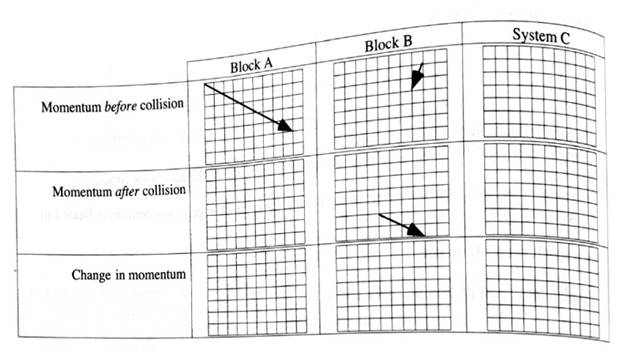
Tutorials in Introductory Physics
1st Edition
ISBN: 9780130970695
Author: Peter S. Shaffer, Lillian C. McDermott
Publisher: Addison Wesley
expand_more
expand_more
format_list_bulleted
Textbook Question
Chapter 3.4, Problem 3bT
The momentum vectors of each block before the collision and of block B after the collision are shown. Complete the table to show the momentum vectors of system C before and after the collision and block A after the collision.

How do the final speeds of the blocks compare? Explain.
Expert Solution & Answer
Learn your wayIncludes step-by-step video

schedule01:28
Students have asked these similar questions
A piece of metal is placed on top of a 2.0 - kg wooden block (mass density = 562 kg/m³) piece. UseArchimedes' principle to calculate the mass (in kg) of copper if the top of the wood surface is exactly at thewater's surface?
A filmmaker wants to achieve an interesting visual effect by filming a scene through a converging lens with a
focal length of 50.0 m. The lens is placed betwen the camera and a horse, which canters toward the camera
at a constant speed of 7.9 m/s. The camera starts rolling when the horse is 36.0 m from the lens. Find the
average speed of the image of the horse (a) during the first 2.0 s after the camera starts rolling and (b)
during the following 2.0 s.
Answer the question (Physics)
Chapter 3 Solutions
Tutorials in Introductory Physics
Ch. 3.1 - A block is moving to the left on a frictionless,...Ch. 3.1 - In a separate experiment, two hands push...Ch. 3.1 - Shown at right is a side-view diagram of the...Ch. 3.1 - Recall the motion of the block in part B. For each...Ch. 3.1 - Generalize from your answers to pans A—D to...Ch. 3.1 - A glider, glider A, Is pulled by a suing across a...Ch. 3.1 - The diagrams at right show two identical gliders...Ch. 3.1 - A block on a frictionless table is connected to a...Ch. 3.2 - Three students discuss the final momentum and...Ch. 3.2 - Which cart takes longer to travel between the two...
Ch. 3.2 - Use Newton's second law and the definition of...Ch. 3.2 - How does the net work done on cart A(Wnet,A)...Ch. 3.2 - Refer again to the discussion among the three...Ch. 3.2 - Release the ball so that it rolls straight toward...Ch. 3.2 - Release the ball at an angle to the ramp as shown...Ch. 3.2 - How does the direction of the net force on the...Ch. 3.2 - How does the change in kinetic energy of the ball...Ch. 3.2 - For motion 1, draw vector in region II of the...Ch. 3.2 - For motion 2, draw vectors in region II of the...Ch. 3.2 - Consider the change in momentum vectors you...Ch. 3.3 - What differences between gliders M and N could...Ch. 3.3 - For experiment 1,draw and label separate free-body...Ch. 3.3 - In the spaces provided, draw and label vectors to...Ch. 3.3 - A student compares the final speeds of gliders M...Ch. 3.3 - A. Suppose that glider D is free to move and...Ch. 3.3 - A second experiment is performed in which glider D...Ch. 3.3 - Consider the two experiments described above. When...Ch. 3.3 - When the momentum of an object or system of...Ch. 3.3 - Two students the second experiment, in which...Ch. 3.4 - Draw separate free-body diagrams for each block...Ch. 3.4 - Rank the magnitudes of all the horizontal forces...Ch. 3.4 - The velocity vectors for blocks A and B are shown...Ch. 3.4 - Use your knowledge of the velocities and changes...Ch. 3.4 - Draw and label a free-body diagram for system C at...Ch. 3.4 - Write an equation for the momentum of system C in...Ch. 3.4 - Generalize from your results to answer the...Ch. 3.4 - Imagine a single object whose mass is equal to the...Ch. 3.4 - What are the external forces exerted on system C...Ch. 3.4 - The momentum vectors of each block before the...Ch. 3.4 - Draw arrows that represent the direction of the...
Additional Science Textbook Solutions
Find more solutions based on key concepts
The following data were obtained from a disk-diffusion test. Antibiotic Zone of Inhibition A 15 mm B 0 mm c 7 m...
Microbiology: An Introduction
Why are the top predators in food chains most severely affected by pesticides such as DDT?
Campbell Essential Biology (7th Edition)
4. Three groups of nonvascular plants are _______, ______, and _______. Three groups of seedless vascular plant...
Biology: Life on Earth (11th Edition)
56. Global Positioning System. Learn more about the global positioning system and its uses. Write a short repo...
The Cosmic Perspective (8th Edition)
Approximately how many feet is the Missouri River above sea level? Height above sea level: _________ feet
Applications and Investigations in Earth Science (9th Edition)
SYNTHESIZE YOUR KNOWLEDGE Watennelon snow in Antarctica is caused by a species of photosynthetic green algae th...
Campbell Biology (11th Edition)
Knowledge Booster
Similar questions
- Hi! I need help with these calculations for part i and part k for a physics Diffraction Lab. We used a slit width 0.4 mm to measure our pattern.arrow_forwardExamine the data and % error values in Data Table 3 where the angular displacement of the simple pendulum decreased but the mass of the pendulum bob and the length of the pendulum remained constant. Describe whether or not your data shows that the period of the pendulum depends on the angular displacement of the pendulum bob, to within a reasonable percent error.arrow_forwardIn addition to the anyalysis of the graph, show mathematically that the slope of that line is 2π/√g . Using the slope of your line calculate the value of g and compare it to 9.8.arrow_forward
- An object is placed 24.1 cm to the left of a diverging lens (f = -6.51 cm). A concave mirror (f= 14.8 cm) is placed 30.2 cm to the right of the lens to form an image of the first image formed by the lens. Find the final image distance, measured relative to the mirror. (b) Is the final image real or virtual? (c) Is the final image upright or inverted with respect to the original object?arrow_forwardConcept Simulation 26.4 provides the option of exploring the ray diagram that applies to this problem. The distance between an object and its image formed by a diverging lens is 5.90 cm. The focal length of the lens is -2.60 cm. Find (a) the image distance and (b) the object distance.arrow_forwardPls help ASAParrow_forward
arrow_back_ios
SEE MORE QUESTIONS
arrow_forward_ios
Recommended textbooks for you
 Glencoe Physics: Principles and Problems, Student...PhysicsISBN:9780078807213Author:Paul W. ZitzewitzPublisher:Glencoe/McGraw-Hill
Glencoe Physics: Principles and Problems, Student...PhysicsISBN:9780078807213Author:Paul W. ZitzewitzPublisher:Glencoe/McGraw-Hill Principles of Physics: A Calculus-Based TextPhysicsISBN:9781133104261Author:Raymond A. Serway, John W. JewettPublisher:Cengage Learning
Principles of Physics: A Calculus-Based TextPhysicsISBN:9781133104261Author:Raymond A. Serway, John W. JewettPublisher:Cengage Learning Physics for Scientists and Engineers: Foundations...PhysicsISBN:9781133939146Author:Katz, Debora M.Publisher:Cengage Learning
Physics for Scientists and Engineers: Foundations...PhysicsISBN:9781133939146Author:Katz, Debora M.Publisher:Cengage Learning Classical Dynamics of Particles and SystemsPhysicsISBN:9780534408961Author:Stephen T. Thornton, Jerry B. MarionPublisher:Cengage Learning
Classical Dynamics of Particles and SystemsPhysicsISBN:9780534408961Author:Stephen T. Thornton, Jerry B. MarionPublisher:Cengage Learning University Physics Volume 1PhysicsISBN:9781938168277Author:William Moebs, Samuel J. Ling, Jeff SannyPublisher:OpenStax - Rice University
University Physics Volume 1PhysicsISBN:9781938168277Author:William Moebs, Samuel J. Ling, Jeff SannyPublisher:OpenStax - Rice University

Glencoe Physics: Principles and Problems, Student...
Physics
ISBN:9780078807213
Author:Paul W. Zitzewitz
Publisher:Glencoe/McGraw-Hill

Principles of Physics: A Calculus-Based Text
Physics
ISBN:9781133104261
Author:Raymond A. Serway, John W. Jewett
Publisher:Cengage Learning

Physics for Scientists and Engineers: Foundations...
Physics
ISBN:9781133939146
Author:Katz, Debora M.
Publisher:Cengage Learning

Classical Dynamics of Particles and Systems
Physics
ISBN:9780534408961
Author:Stephen T. Thornton, Jerry B. Marion
Publisher:Cengage Learning

University Physics Volume 1
Physics
ISBN:9781938168277
Author:William Moebs, Samuel J. Ling, Jeff Sanny
Publisher:OpenStax - Rice University
